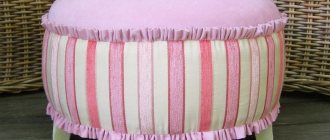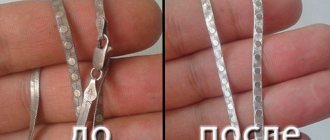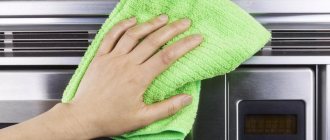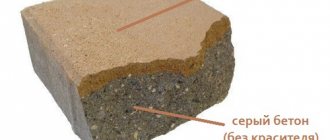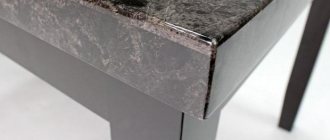05/01/2017 Maria Ivanova 2 comments
Raise your hands, who loves something baked: meat, fish, pies? Everyone loves it.
What if the oven is covered with a layer of nasty grease and smearing soot? We don't see a single hand. How to clean the oven from old burnt fat? We're willing to bet that many of you are now thinking, “I clean it, but it's still greasy. I heard that stoves are self-cleaning.”
Yes, there are such plates. But civilization reaches our native land only with difficulty, and most of the ovens we have at home do not have this ability. We'll have to use what we have in the kitchen (or what we can buy just across the street). Oddly enough, this should be enough.
Store-bought oven cleaners
The easiest way to quickly clean carbon deposits is to use special products. They are suitable for cleaning Bosch, Electrolux ovens and household appliances of other brands. Such products are specifically designed to remove old grease from the surface of built-in ovens. They can be used at home.
Such products contain acids or alkalis that remove stubborn fat without any effort. They are usually available in the form of a gel or spray, which can be easily applied to the inside of the oven. After applying them, wait 5 to 30 minutes. Then simply wipe the surface with a sponge. During this time, the carbon deposits will dissolve.
Pay attention to the following products that will help you easily wash away old fat:
- "Shumanite";
- Amway Oven Cleaner;
- "Shine";
- Faberlic;
- Sanita Anti-grease.
All these products are caustic, you need to work with them strictly according to the instructions, you need to take into account the cleaning time and method of application.
Be sure to use rubber gloves.
For example, let's look at how to clean an oven using Schumanite.
This is a caustic agent that can cope with any contaminants. It is often used by professional chefs. If you clean the oven with it at home, you need to proceed as follows:
- put on gloves, open the windows;
- apply the product to the walls, door;
- leave the oven closed for 5 minutes;
- remove with a soft sponge;
- rinse it with clean water.
If you don’t have such a product at home, you can take those chemicals that are often used. Sometimes housewives are interested in whether it is possible to clean the oven with Domestos. Use this product in the form of a cream and then thoroughly remove its remnants from the inside of the thermal chamber.
A little salt and the oven is clean
Cleans grease : yes.
Cleans soot : partially.
Yes, regular table salt. Cheap and cheerful. Cleaning the oven with salt at home can be done in two different ways.
First: cover the surface of the oven with salt and turn on the oven.
Check the appearance of the surface periodically: when the salt turns brown, turn off the oven, let it cool, then wash off the salt that has absorbed the fat. No harmful fumes or unpleasant odors.
Salt method number two involves placing a pan with a water solution of salt in the oven, turning on the stove and letting the water evaporate for a while.
Twenty minutes is usually enough. After this procedure, fat and soot are also easily washed off.
How to clean an oven with vinegar and soda
Fresh dirt inside an electric oven can be easily washed off with baking soda and vinegar.
These are the most affordable means, they are in every home. The effectiveness of such cleaning is explained by the fact that these two substances enter into a violent chemical reaction, releasing carbon dioxide. It destroys the fat deposits inside the thermal chamber. How to clean the oven from old fat in this way?
- Make a paste with 2 tbsp. soda and 50 ml of water.
- Apply it in a thick layer on the doors, walls, ceiling and bottom.
- . Wait 1-2 hours.
- Without removing the baking soda, spray the inside with vinegar using a spray bottle.
- Wait for the reaction to subside, usually 15 minutes is enough.
- Rub with a brush and, if necessary, scrape off dirt with a spatula.
- Rinse the surface with clean water.
Please note: this is the most effective way to clean carbon deposits from the inside of glass.
Folk remedies
The most proven and safest choice is to clean the oven from grease using traditional methods. They do not cause allergic reactions, have a gentle effect on dirt, and do not harm the surface. However, such methods will not cope with many years of thick layers of soot.
Soda and vinegar
You can remove grease and carbon deposits from the oven using baking soda and acetic acid. How to use:
- Use a sponge or brush to scrape off any remaining food.
- Mix 9% vinegar with soda in a ratio of 1:2, mix well. For a better effect, you can add a couple of drops of dishwashing liquid.
- Spread the mixture over the surface with a soft sponge or brush, leave for 1-2 hours, then rinse thoroughly and wipe dry.
Dish soap + citric acid
Another way to clean the oven and get rid of old burnt fat, the ingredients for which can easily be found in the kitchen.
Algorithm of actions:
- Prepare a fireproof container with a solution: 500 ml of water, 20 g of lemon, 2-3 drops of detergent.
- Preheat the oven to 200°C, place a container inside and wait until it boils.
- Turn off the heat and wait until the liquid cools down.
- Clean the bottom and walls with a sponge, you can use the hard side.
There is another option, take the same ingredients, but pour the resulting solution into a bottle with a spray bottle and spray all surfaces with it. The fat will soften and the oven will be easy to clean.
Ammonia
Ammonia copes with many types of stains; it will also help clean an electric oven from carbon deposits.
This is a fairly caustic liquid, so before using it, you must wear protective gloves and a mask, and open the windows.
There are several options for cleaning the oven with ammonia.
Method 1
Soak a sponge in alcohol, clean the oven walls with it, and rinse off after 10-12 hours.
Method 2
Place the grill down, place a container into which pour 1 liter of warm water, bring it to a boil, turn off the heat. Next, install another wire rack over the container with water, and place a bowl with 200 ml of ammonia on it. Leave everything like this overnight. In the morning, prepare a solution of ammonia with water (1:4), soak a sponge in it and clean the surface.
Attention! After the procedure, you need to ventilate the oven very well, otherwise the pungent smell of ammonia will penetrate into the food and not only spoil its taste, but also make it dangerous.
Baking powder
Baking powder, or baking powder, is used not only in cooking, but also for cleaning. It makes the fat porous and clumps it, making it easier to remove.
To clean a dirty oven, you need to mix baking powder with water, based on the calculation: 1 sachet per 2-3 tbsp. l. liquids. The resulting mixture should be evenly distributed over the surface, and after 2-3 hours, wash off the remaining fumes with a damp sponge.
Laundry soap
You can also clean an oven covered with grease and carbon deposits using laundry soap. The large amount of alkali in its composition effectively breaks down contaminants. Procedure:
- Rub half a bar of laundry soap into shavings and dissolve it in 500 ml of hot water.
- Pour the resulting liquid into a refractory form, put it in the oven, and bring to a boil at a temperature of 150°C.
- Leave for 1.5 hours, then clean the walls, bottom and door with a hard sponge.
- After cleaning, it is advisable to leave the oven door open overnight to air it out.
How to clean the oven with ammonia
One of the most effective ways to clean glass and oven doors is to use ammonia. It is not very pleasant, as this product emits a pungent odor. But if all protective measures are taken, it will not cause harm. The effectiveness of ammonia against carbon deposits is explained by the fact that its vapor softens fat.
You will need 5 regular bottles of ammonia; they are poured into a small bowl. You need an even larger bowl of boiling water. How to clean fat using ammonia?
- Preheat oven to 1800, turn off.
- Place a saucepan with boiling water on the bottom and a bowl of ammonia on the grill.
- Close the door and leave for half an hour.
- If the plaque is old, you can leave it overnight.
- Clean off dirt with a sponge and baking soda.
- Rinse all surfaces clean.
When using this method, be sure to open the window in the kitchen. It is advisable not to inhale ammonia fumes as they are toxic.
Cleaning the oven at home using baking soda and vinegar
Still, chemistry is chemistry with all its shortcomings. But it can be perfectly replaced by natural remedies - our friends vinegar, soda, soap.
The safety rules described above also apply to natural cleaning products. So we wear gloves.
Pour some table vinegar into a cup. Using a sponge, wipe all the walls of the oven and leave for about five minutes.
If the oven is not very dirty, you can wipe it with a soapy sponge and rinse with water.
In case of severe contamination or burnt fat, wipe the oven with another mixture of vinegar and soda.
Most likely, the vinegar that we poured into the cup will become dirty, replace it with a new one, add soda (about a third of the pack), stir well until it becomes mushy.
Using this composition we wipe all contaminated areas of the oven. Leave again for a while.
We wipe everything with a damp sponge, if necessary, we rub off the stains, now they are easy to clean.
Do not use hard washcloths, as they leave microcracks in the enamel.
We wash everything off with water and wipe dry.
You can try cleaning the oven from carbon deposits as follows.
Add laundry soap to the mixture of vinegar and soda. It needs to be grated. Mix thoroughly, apply to the oven walls and leave for two hours. Then wipe with a sponge and rinse with water.
This composition can be used to clean glass, baking trays, handles, and grates. This method does not damage the enamel and copes well with old stains.
Read about other ways to use vinegar at home here>>.
How to clean the oven with peroxide and soda
These substances are also available and found in every home.
When they are combined, an effective product is obtained that removes grease from any metal and enamel surfaces. Therefore, it can be used when the question arises of how to clean the oven grates, tray and walls. The cleaning method is very simple. Mix baking soda and hydrogen peroxide to form a paste. Using a brush or sponge, apply it to all dirty areas. Depending on the degree of contamination, you need to leave it in this form for 20-40 minutes. Scrub afterwards with a brush, and then rinse off with water.
Clean the electric oven: Comet paste
Cleans grease : yes.
Cleans soot : yes.
To clean an electric oven at home, there is a special cleaning paste. Take citric acid, dishwashing detergent and cleaning powder a la Pemolux, Comet and the like. These components must be mixed in a one to one ratio.
Now, as in the case of the baking soda and vinegar paste, all surfaces must be exposed to the paste. Since the electric oven is more delicate, you should keep it covered with paste for no more than an hour. After the hour is up, you will need plenty of warm water to wash off the paste.
How to clean the oven with citric acid
This is the fastest way to help clean glass, walls, and baking trays until they shine. If the stains are not strong and fresh, then you can take lemon juice. Use it to wipe all surfaces or spray it with a spray bottle. Leave for half an hour, rinse with water. You can mix the juice in equal parts with water or wipe the stains with a slice of lemon.
The second method is suitable for stubborn stains. Heating is used for this.
- Preheat oven to 1500.
- Place a baking tray or bowl with water in which citric acid is dissolved
3. Heat this solution for 30-40 minutes.
4. Cool and wipe with a sponge. If some stains persist, clean them with baking soda.
To maintain the correct proportions, you need to add 1 sachet of citric acid to 500 ml of water.
Video; how to clean an oven easily and cheaply
Cleaning Recommendations
The most important thing is to avoid the formation of grease and carbon deposits, you need to wash the oven immediately after cooking. Moreover, it must be hot, then the plaque is easier to clean. If the oven is used frequently, it is recommended to periodically steam it with water and dishwashing detergent. And in the case when you have to use aggressive methods, use simple tips:
- do not use steel wool, scrapers or other abrasives that can damage the surface;
- do not apply cleaning agents to the fan or heating elements;
- rinse the inside surface well and ventilate the oven, especially after using products with a strong odor;
- If the smell remains, place a container with crushed activated carbon tablets inside.
Cleaning the oven from carbon deposits and stubborn grease is not difficult; there are many accessible ways to do this. But it is better to prevent such contamination by cleaning it after each cooking.
Is there a difference in cleaning an oven and a stovetop oven?
The oven and hob are connected to different outlets.
The oven should be switched off before cleaning. And the hob can be used.
In the case of a stove with a built-in oven, unplug the entire stove. You cannot cook on it while cleaning is in progress.
Otherwise, there is no difference between cleaning an oven and a stovetop oven.
How to clean a baking sheet from the oven
Cleaning the baking sheet will not be difficult for you. In most cases, it is enough to simply soak it in a hot soapy solution and remove any remaining dirt with a sponge. Another way is to wash the baking sheet in the dishwasher if it fits in it.
If the baking sheet is old and the dirt cannot be washed off, the heating method will come to the rescue: fill the baking sheet with soapy water, put it in the oven at 120-150 degrees for 10-15 minutes. Once the pan has boiled, it will be easy to clean. For complex stains, additionally use special compositions for cleaning ovens.
Review of Amway oven cleaner (Amway)
The stove cleaner from the American manufacturer Amway removes greasy stains of varying degrees of complexity well. Not suitable for aluminum, painted or chrome plated boards.
Main advantages:
- thick consistency;
- economical consumption;
- removes contaminants of varying degrees of complexity;
- no pungent odor.
When working, you need to apply a small amount of gel to the surface, spread and wait half an hour. The gel breaks down dirt, and you can easily wash off any remaining product.
When using a product for Faberlic or Amway slabs, it may be necessary to re-use it if the slab is heavily soiled. This is fine. Heavy contamination requires a lot of effort.
Additional recommendations
When cleaning the oven, one should not forget about the ventilation and lighting.
The ventilation hole can be easily cleaned using a brush with hard bristles or a toothbrush. If necessary, you can wipe the fan with a sponge soaked in soapy water. The lampshade can be carefully removed and washed with the same products that were used to clean the door.
A steam generator will also help soften hardened dirt and rid the oven of grease and carbon deposits. Treat surfaces and wipe with a damp cloth or sponge. This method will also help remove dirt from hard-to-reach places and crevices.
What not to clean
When cleaning the oven, it is not recommended to use chemically active compounds such as acids or chlorine. Also, do not use abrasive products or tools such as metal sponges, brushes, or cleaning powders. They can corrode or scratch the enamel. It is better to use special products designed for cleaning these surfaces.
How to remove detergent odor
If you clean the oven with commercial cleaning products, unpleasant odors may remain after treatment. Here are several ways to destroy them:
- Ventilate the oven.
- Rinse surfaces thoroughly.
- Place a baking tray with activated carbon dissolved in water inside. Heat to 100° and hold for several minutes.
- Wipe surfaces with water and vinegar or lemon juice.
How to clean the oven - choice of products
All products that will help clean an electric oven can be divided into 3 groups: homemade, household chemicals and special compounds.
When choosing a cleaning method, consider:
- your financial capabilities;
- type, area and freshness of contamination;
- influence of active substances on the health of family members.
For weakly ingrained stains, choose home remedies that any housewife usually has on hand: water, vinegar, salt, soda, ammonia, citric acid, laundry soap. With their help, you can properly wash grease and soot in an electric oven without significant financial costs or harm to health.
Buy household chemicals at the store. Its selection is wide, and the price starts from 30 rubles. It has universal use (washing dishes, tiles, kitchen surfaces) and contains chemically active substances that can break down fat and carbon deposits. To avoid harm to health, use household chemicals according to the instructions and thoroughly wash the surface of household appliances.
Special remedies for burnt fat have a narrow application. These are powders, gels, aerosols designed specifically for electric ovens. Use them on very dirty surfaces and old stains. As a rule, they have a caustic composition (acids, alkalis), a specific odor and a high price.
When cleaning, wear rubber gloves. When working with aggressive substances, use protective clothing, a mask, and goggles.
The best oven products
On the shelves of household chemical stores you can find many compositions for cleaning the oven from old grease and carbon deposits. Each manufacturer has a series for the kitchen. The most popular cleaning products on supermarket shelves are Shumanit (Israel), Azelit (Russia), Sanita (Russia), Frosh (Germany), Unicum Gold (Russia); from chain stores - Faberlic, Amway. Oven cleaning products are available in the form of gel, foam, spray, and powders. They differ in price and active formula. You can find reviews on the Internet for each manufacturer, but their effectiveness has been proven by time. In addition to store-bought options, there are folk compositions that you can prepare yourself.
How to clean the oven from carbon deposits
While cooking, sauces and juices may spill onto the lower rack and get baked on it. If you don’t get rid of the dirt right away, carbon deposits will form when you reuse the oven. Many people try to wipe off old carbon deposits with metal sponges or a knife, which is absolutely forbidden to do, as this can damage the top layer of the oven. Tips on how to get rid of soot. If carbon deposits have already formed, try cleaning them with any slab cleaner. Don't be afraid to repeat the procedure. If you don't want to use store-bought household chemicals, make a solution of soda and vinegar, or use a steam generator.
Good habit: if something spills on the lower tier of the oven, wipe up the liquid with a regular damp cloth immediately after cooking, after the oven has cooled down.
How to clean at home
A gas oven can be cleaned not only with household chemicals, but also with improvised means that are found in every home. Let's look at the most common and effective methods.
Baking powder for grease stains
Grease stains can be removed quickly using baking powder, as well as a mixture of soda and citric acid:
- Apply to stain.
- Sprinkle with water.
- Leave for 15 minutes.
- Rinse it off.
Salt from old carbon deposits
Regular rock salt will help to cope with dirty surfaces inside the oven:
- Moisten the oven surface with water.
- Distribute the salt.
- Preheat oven to 100°.
- Wait for half an hour. When heated, salt will absorb carbon deposits and acquire a dark brown color.
- Turn off the oven and wait until it cools down.
- Wipe with a cloth soaked in cold water.
Ammonia for difficult stains
Another effective way to deal with grease stains is to use ammonia:
- Wipe the oven surfaces with ammonia.
- Leave for half an hour.
- Rinse thoroughly with a wet cloth.
The use of ammonia requires thorough ventilation of the room during cleaning. To get rid of stubborn stains and carbon deposits, dip a cloth soaked in ammonia in baking soda and apply to problem areas. Leave on for a few minutes and rinse off.
Hydrolytic oven cleaning method
You can also clean a gas oven using steam.
After the dish has cooled down, place a baking sheet in the oven with detergent diluted with water. The oven is heated to 90–95 °C and kept for about half an hour. After the device has cooled, the surfaces are thoroughly wiped.
A good method for people prone to allergic reactions to cleaning products:
- Soften the laundry soap and dilute it with water.
- Wipe the walls and door of the device with this mixture.
- Fill a baking tray with this liquid and place in the oven.
- Turn on the device for half an hour (heat to a temperature of 120–140 °C). For severe and old stains, this time can be increased to an hour.
- Wait for the oven to cool and wipe all surfaces with a damp cloth.
Do not open the oven door during heating or immediately after turning off the appliance. Otherwise, there is a risk of getting burns to your hands and face.


